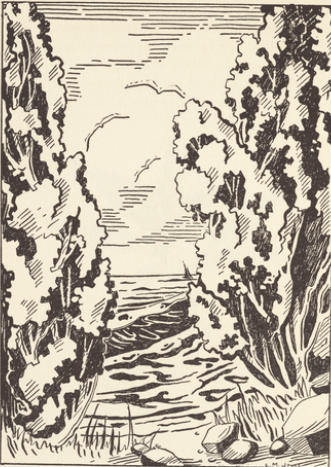Wind-Stirred Trees
By Effie Lee Newsome
Annotations by Karen Kilcup

by Lois Mailou Jones. Public Domain.
A tall, proud poplar’s like the ocean[1] In tossing sound and wind-swept motion. There’s nothing more like voice of sea Than roaring billows of a tree, And one things of the foam-fringed tide As poplar leaves wave their white side.
Newsome, Effie Lee. “Wind-Stirred Trees.” Gladiola Garden: Poems of Outdoors and Indoors for Second Grade Readers. Washington, DC: Associated Publishers, 1940, 123.
[1] Numerous types of poplar trees appear across the United States. As Newsome notes, their leaves quiver in the wind, and many have white undersides. One of the most famous types is the quaking aspen.
Contexts
Newsome worked among the many celebrated writers of the Harlem Renaissance, who included Langston Hughes, Countee Cullen, James Weldon Johnson, Zora Neale Hurston, and Anne Spencer, many of them poets. Among her noteworthy contributions to that movement was her writing and editing for W. E. B. Du Bois’s magazine, The Crisis, the official publication of the NAACP (National Association for the Advancement of Colored People). As John Claborn points out, Du Bois’s political goals embraced the idea of access to natural spaces, and the magazine featured environmental writing by such notable authors as Arna Bontemps, Claude McKay, and Hughes. Newsome contributed to and edited “The Little Page” (“Whimsies for the Younger Folk”), where much of her work emphasized nature. This poem, like many others in The Envious Lobster, whimsically enacts a natural history lesson, while it encourages children’s imagination.
Resources for Further Study
- Claborn, John. “The Crisis, the Politics of Nature, and the Harlem Renaissance: Effie Lee Newsome’s Eco-poetics.” Civil Rights and the Environment in African-American Literature, 1895-1941. New York: Bloomsbury Academic, 2017.
- “Effie Lee Newsome, 1885-1978.” Poets.org. This site provides access to seven of Newsome’s poems.
- Newsome, Effie Lee. Gladiola Garden: Poems of Outdoors and Indoors for Second Grade Readers. Courtesy of the New York Public Library, this site provides access to the entire text.
Contemporary Connections
Anonymous. Reading of Newsome’s poem, “The Bronze Legacy.” The illustrations for Gladiola Garden were done by prominent Black artist Loïs Mailou Jones (1905-1998).
Johnston, Amber O’Neal. “African American Poetry: Effie Lee Newsome. Heritage Mom blog.
“Fast-Growing Poplars Provide Solutions for Both Energy and Pollution Problems.” US Forest Service Northern Research Station 19 (Winter 2013).